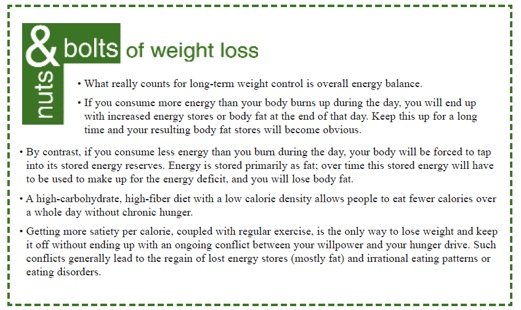No matter what you eat, your body will always burn it for energy. If you eat more protein, it does not, for the most part, get stored as muscle ? it gets used as fuel. If you eat more carbohydrate (CHO) you will burn more CHO and may end up with a little more stored glycogen than if you ate less CHO and more fat. If you eat more fat, you burn more fat. Whether your body weight goes up or down depends on energy balance and not the ratio of fat to CHO to protein in the diet. If you eat excess calories, your body will store some of the fat you eat as body fat. The body has little ability to store many calories as CHO or protein, so these get burned for energy. Under most circumstances, it is primarily the dietary fat that gets stored as body fat. This is true whether your diet is 10, 30, 50 or 70% fat calories. Now, if you ate twice as many calories as you needed each day for several days and were eating a diet with only 10% fat and 80% carbohydrate, it is very clear that some CHO would have to be converted to body fat (and some protein, too).
You hear people say, if you want to burn more fat, you should exercise at a lower intensity. This is a myth. The absolute amount of fat burned increases with increasing exercise intensity (even though not as much as the amount of CHO burned). So more intense exercise actually usually burns fat more rapidly than less intense exercise. Prolonged exercise will also help burn more fat because as stored CHO is depleted, the fuel mix starts to gradually shift to more fat, a little more protein and a lot less CHO (you can?t burn what you don?t have).More intense exercise actually burns a little more fat and a lot more calories per minute than long, slow, distance exercise. But people simply cannot maintain a very fast pace for very long, and in the end it is the distance you travel that mostly determines the total calories burned. It should be noted however, that very long exercise bouts will significantly increase hunger and so the impact on body fat stores is often less than one would hope.Conversely if one is very sedentary, just walking for several miles a day has little impact on appetite or hunger. It is generally the first 5-6 miles of walking or running per day that have the most impact on body fat stores. If you double your mileage from 6 to 12 miles a day it will probably have little impact on your body weight because it will probably make you hungrier. However, if a sedentary individual starts walking even 3 miles a day, this will likely produce a significant drop in body fat stores because it will have little or no impact on appetite or hunger. Obviously if you burn more calories and consume the same amount of calories, body fat stores must be used up for energy.When you eat more CHO you replenish your glycogen stores more quickly and you can also produce larger amounts of glycogen stored in the muscle. Depletion of glycogen stores can lead to reduced endurance.The body can produce energy from CHO more quickly than from fat. Those who eat a high-CHO diet before an event and start with more glycogen can run faster or bike faster for a longer period of time without becoming exhausted. This is why a high-CHO diet can enhance performance in endurance events.
The bottom line:So why should we recommend a diet with lots of high-fiber, high-carbohydrate foods for weight loss? Because these foods, which include fruits, vegetables and whole grains, usually provide more satiety per calorie than high-fat foods. That means people feel satisfied on fewer calories, so they eat fewer calories and reduce their body fat stores. Of course it is even better if they can walk 3 miles a day, on most days, too.
By James J. Kenney, PhD, RD, LD, FACN.

